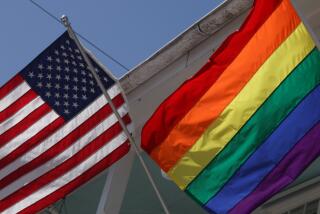Defining the New Sexuality : THE INVENTION OF HETEROSEXUALITY, <i> By Jonathan Ned Katz; foreword by Gore Vidal; afterword by Lisa Duggan (Dutton: $22.95; 291 pp.)</i> : THE APARTHEID OF SEX: A Manifesto on the Freedom of Gender, <i> By Martine Rothblatt (Crown: $21; 178 pp.)</i>
- Share via
Recently, in Manhattan’s Central Park, I overheard an interchange between a little girl and her mother that highlights the currently heated debate about whether gender roles are innate or learned, natural or invented.
“I’ve had enough practice being a girl,” the little one said. “Now I want to practice being a boy.”
I wondered what the mother would say. This was, after all, New York, and I expected her answer to reflect progressive views.
But, no. The mother trotted out the conservative commonplaces, telling her daughter, “You were born a girl and will always be one. Girls are different from boys and behave in different ways. When you grow up, you’ll marry a man you love and have babies. That’s what’s special about being a girl.”
The daughter, though, was savvier about the various forms that love, living arrangements and procreation now take. “But my friend’s mom had babies from the same man’s seeds. They were from a humonimous [anonymous] donor!”
The little girl concluded that she didn’t have to be married to a man to have a baby. But her mother replied, “That’s not the way it’s supposed to be.”
I wanted to tap the mother on the shoulder. Tell her that the way it’s supposed to be for girls and boys has changed and will continue to change. I wanted to suggest that she read Martine Rothblatt’s “The Apartheid of Sex” and Jonathan Ned Katz’s “The Invention of Heterosexuality,” two engaging and important books. Among the best books I have read on sexual identity, they can change the way you think about sex and gender, about yourself and about whom you might become.
The subtitle of Rothblatt’s “The Apartheid of Sex” is “A Manifesto on the Freedom of Gender.” Just as provocative as Virginia Woolf’s “Three Guineas” (1938), “Apartheid of Sex” is likely to provoke outrage and to enable us to redefine our potential as human sexual beings. While Woolf argued that male domination of women was a kind of Fascism, Rothblatt (a consultant to the International Bar Assn.) contends that women continue to be subordinated, only by means that are often more subtle.
Our culture’s “longstanding and rigidly enforced” division of humanity into two sexes, Rothblatt writes, has “supported the suppression of women into a position of inferiority” even though there is no real biological dividing line between women and men. Scientific evidence points, instead, to a continuum of sex types. And “if there are no hard and fast sex types, then there can be no apartheid of sex. If there is no apartheid of sex, then there is no entrenched birthright of power--people must achieve on their own. To men threatened by economics and social survival, loss of birthright superiority is frightening.”
Rothblatt’s most innovative chapters propose a continuum of sexuality; describe the revolutionary potential to sexual expression of cyberspace (where we can easily “pretend to be a different sex”); and chronicle the technological revolution that has “freed us from any conceivable basis for the separation of people into two classes based on gonads, genitals, or chromosomes.”
Similarly, Jonathan Ned Katz (author of “Gay American History: Lesbians and Gay Men in the U.S.A.”) traces the evolution of his discovery that heterosexuality was not only “enforced,” as others have argued; “it was ‘invented.” To say that it is invented means, of course, that it is not an immutable, normal feature of human behavior: Like homosexuality, it is “a social-historical construction.”
In medical journals of the 1890s, “heterosexuality” was first used to denote sexual perversion; since the word’s meaning has changed through time, Katz asks, might not the sexual practices it denoted also have changed? Heterosexual love, he concludes, has indeed been “understood and valued” differently through time. As a definition of normative behavior, it is “a modern invention,” in wide use for only the last three-quarters of the 20th Century.
The major focus of Katz’s work is the shifting meaning of the definition of heterosexuality and, by implication, the practice it denotes, during the late-19th Century, (when the term and concept were created and in flux) and from 1960 on (when the term was reinterpreted by feminist, gays and lesbian thinkers).
In ancient Greece, as the philosopher Michel Foucault has observed, love for one’s sex and for the other sex were not opposites; they could coexist in the same person. Instead, earthly and heavenly love were the polarities defining different kinds of love. In the New England colonies, “fruitfulness and barrenness,” not “different-sex and same-sex eroticism,” were polarities: so, both adultery and sodomy were criminal acts. Men and women, though were believed “equal in lust.”
The most exciting of Katz’s explorations traces the shifting meanings of heterosexuality through the works of such social theorists as Karl Heinrich Ulrichs, Karl Maria Kertbeny, James G. Kiernan, Richard vonKrafft-Ebing, and Sigmund Freud. The word heterosexual was introduced into the English language in Kiernan’s work in 1892 to denote the perversity of those who erotically desired both men and women. “Heterosexuals” were also inclined to practice “abnormal methods of gratification”--those that did not reproduce the species.
Krafft-Ebing then introduced the notion that sexual practice could be either healthy or unhealthy. He changed the meaning of the term to signify sexual desire for one of a different sex. By implication, though, only sex linked to possible procreation was normal, healthy and good. Sex for pleasure was abnormal, unhealthy and bad. Onanism, anal sex, oral sex and same-sex sex were inherently perverse sexual practices.
This artificial line between “healthy” and “unhealthy” came to dominate the 20th-Century view of sexual practice. The idea that heterosexuality was an “immutable fact of nature” emerged from Krafft-Ebing’s belief that certain sexual anomalies are not chosen, they are inborn and therefore involuntary. The notion that males and females are “opposites” also can be traced to Krafft-Ebing’s work; he defined men, by nature, as active, women, passive.
To Freud, feelings, not acts, define one’s sexual inclination: “hetero feeling defines hetero being, whether or not one acts heterosexually.” Heterosexuality is now seen as a normal, mature, different-sex eroticism in contrast to homosexuality, which is abnormal and immature (hence inferior).
Heterosexuality, for Freud, was not innate. For it to evolve required the repression of oral and anal drives and a journey beyond incestuous lust for the parent of the opposite sex.
Katz’s analysis of Freud’s idea of heterosexuality achieved through a deeply disturbing psychic drama is brilliant, as is his analysis of Freud’s work with Dora. Dora’s lack of erotic response to Herr K’s advances (not his inappropriate advances) is abnormal.
Equally important is Katz’s tracing of “heterosexual” through the 1960s, when it denoted an erotically correct ideal that affirmed “the superiority of men over women and heterosexuals over homosexuals.” Less exciting and more familiar is Katz’s tracing of how women--such as Betty Friedan, Ti-Grace Atkinson, Kate Millett, Gayle Rubin, Nancy Myron and Charlotte Bunch, Adrienne Rich, Margaret Small and Monique Wittig--in the modern feminist and radical lesbian movements, recast the “heterosexual order . . . as problematic,” linked to oppression and as “an organized practice of unequal power in which men dominate women and heterosexuals dominate homosexuals.”
In his conclusion, “Toward a New Pleasure System,” Katz shows the far-reaching ramifications of the notion that heterosexuality is merely “an invented tradition.” The sexual practices of homosexuals and heterosexuals value pleasure over procreation; living arrangements of homosexuals and heterosexuals are converging: both groups cohabit without marriage. Heterosexual and homosexual, as contrasting terms, Katz concludes, may become obsolete.
After having read these books, I wanted to tell that mother in Central Park that because her daughter was born female does not necessarily bind her to any special way of behaving; it does not require her living with a man and having his baby. That if her daughter chooses, in the future, to change her sex, there are many ways she can do this. That her daughter might chose to love no one, herself, one other woman, one other man, one other transsexual, or a series of other women and/or men or transsexuals. That sex, behavior and sexual practice exist along a continuum.
That when her daughter can have babies, if she wants to have them, the term heterosexual may have very little meaning, and the daughter’s “husband” (if she chooses to have one, and if he is male and if such a relationship is still recognized) might very well be the partner gestating their baby in one of his body cavities.
These possibilities, explored so thoroughly in these two books, mark the possible emergence of a far more ethical and tolerant future, one heralded by both Rothblatt and Katz.
More to Read
Sign up for our Book Club newsletter
Get the latest news, events and more from the Los Angeles Times Book Club, and help us get L.A. reading and talking.
You may occasionally receive promotional content from the Los Angeles Times.






